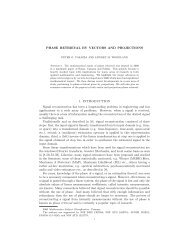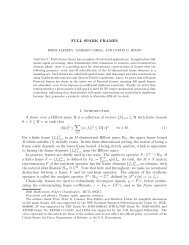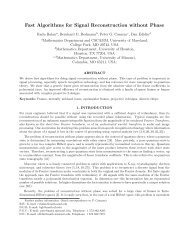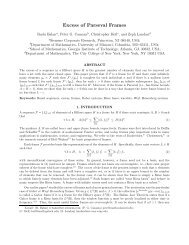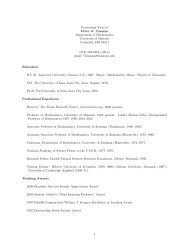Introduction to Finite Frame Theory - Frame Research Center
Introduction to Finite Frame Theory - Frame Research Center
Introduction to Finite Frame Theory - Frame Research Center
Create successful ePaper yourself
Turn your PDF publications into a flip-book with our unique Google optimized e-Paper software.
<strong>Introduction</strong> <strong>to</strong> <strong>Finite</strong> <strong>Frame</strong> <strong>Theory</strong> 7<br />
The notion of orthogonal direct sums, which will play an essential role in Chapter<br />
[166], can be regarded as a generalization of Parseval’s identity (Proposition 1).<br />
Definition 3. Let (W i ) M i=1 be a family of subspaces of H N . Then their orthogonal<br />
direct sum is defined as the space<br />
( M∑<br />
i=1⊕W i<br />
)<br />
with inner product defined by<br />
〈x, ˜x〉 =<br />
M<br />
∑<br />
i=1<br />
l 2 := W 1 × ... × W M<br />
〈x i , ˜x i 〉 for all x = (x i ) M i=1, ˜x = ( ˜x i ) M i=1 ∈<br />
( M∑<br />
i=1⊕W i<br />
)<br />
The extension of Parseval’s identity can be seen when choosing ˜x = x yielding<br />
‖x‖ 2 = ∑ M i=1 ‖x i‖ 2 .<br />
l 2 .<br />
2.2 Review of Basics from Opera<strong>to</strong>r <strong>Theory</strong><br />
We next introduce the basic results from opera<strong>to</strong>r theory used throughout this book.<br />
We first recall that each opera<strong>to</strong>r has an associated matrix representation.<br />
Definition 4. Let T : H N → H K be a linear opera<strong>to</strong>r, let (e i ) N i=1<br />
be an orthonormal<br />
basis for H N , and let (g i ) K i=1 be an orthonormal basis for H K . Then the matrix<br />
representation of T (with respect <strong>to</strong> the orthonormal bases (e i ) N i=1 and (g i) K i=1 ) is a<br />
matrix of size K × N and is given by A = (a i j ) K , N<br />
i=1, j=1 , where<br />
a i j = 〈Te j ,g i 〉.<br />
For all x ∈ H N with c = (〈x,e i 〉) N i=1<br />
we have<br />
T x = Ac.<br />
2.2.1 Invertibility<br />
We start with the following definition.<br />
Definition 5. Let T : H N → H K be a linear opera<strong>to</strong>r.<br />
(a) The kernel of T is defined by kerT := {x ∈ H N : T x = 0}. Its range is ranT :=<br />
{T x : x ∈ H N }, sometimes also called image and denoted by imT . The rank of<br />
T , rankT , is the dimension of the range of T .



